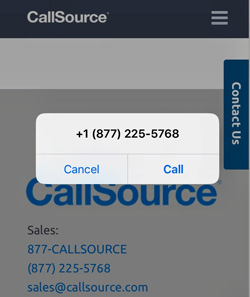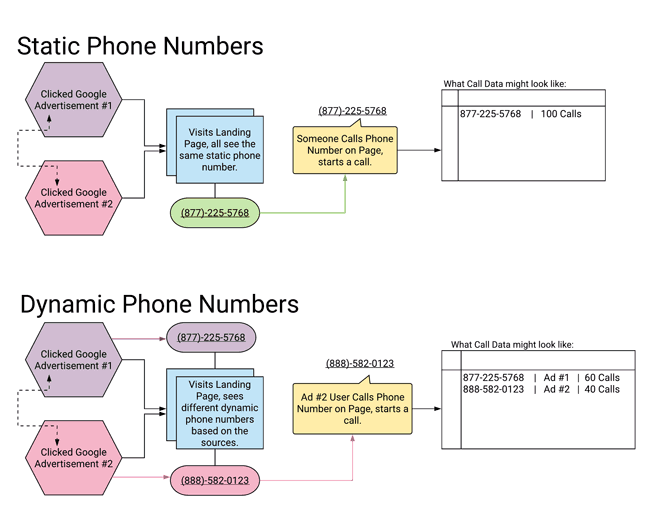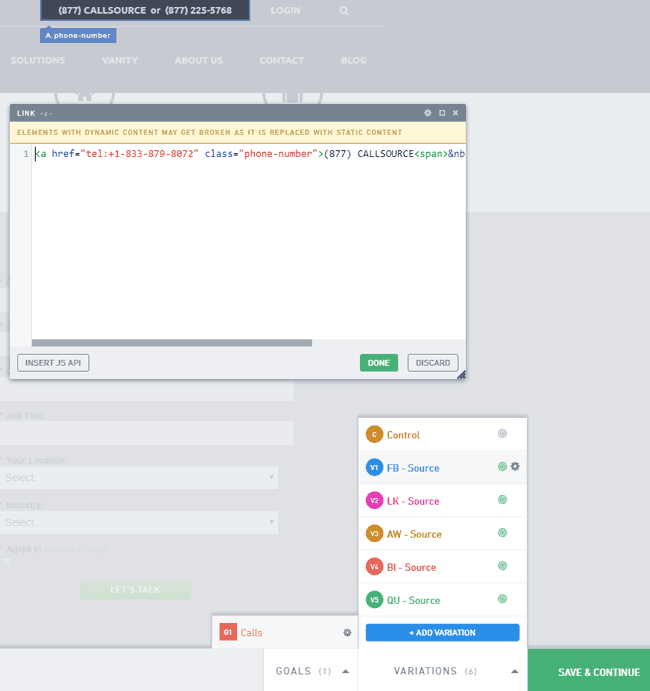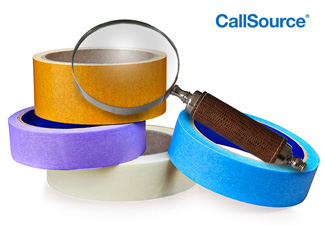The best way to track your phone calls online is to track 100% of calls made online reliably.
As a marketer, it’s easy for you to track a form being filled out and a thank you page being viewed, yet many marketers stumble when it comes to tracking phone calls online correctly.
Featured Video:
While call tracking can solve this problem, not every company can afford call tracking solutions. Thus marketers roll up their sleeves and sink hours of time into learning shortcuts and back-alley, free end-around to everything.
Sometimes free can be good enough. Without reliability, it free solutions do not help your company make sound business decisions. Based on the assumption that we reliability is a must, let’s define good ways, bad ways, and the right way to track phone calls.
Reliable call tracking enables marketers to confidently source all of your inbound phone calls back to a campaign or promotional effort. It is important to note that not all call tracking providers all created equal – at the end of the day you are tracking calls for the results and a return, so a call tracking provider that does not have near-perfect uptime is not worth its effort.
Before we dive into different methods of tracking your calls online, make sure your customer journey is mapped out.
Mapping your customer journey is crucial before you track your phone calls online. This is necessary for a solid understanding of when your customers are presented phone calls in your marketing funnel.
Companies that heavily lean on phone calls to set appointments demo their products or discuss services often find that phone calls are pivotal to their business and can pinpoint how much revenue comes from every single call.
The more revenue a call is worth, the more important it is to track your phone calls. Additionally, the more money you spend on advertisements, the more companies tend to spend on reliable (there’s that word again!) call tracking.
Ok, from the worst to the best (or least reliable to most reliable) duct-tape online call tracking marketing solutions, let’s get into them all.
4) Asking the caller
“if it ain’t broke, don’t fix it.”
– Thousands of legacy sales teams who use this solution
There was a time that asking the caller how they heard about your business was the only way to know what made them call. “This is (888)-777-9999? I think I saw it online somewhere.” We’ve all heard this dismissive quote, “If it ain’t broke, don’t fix it” regarding multiple things – but is that a good way to look at your business or to be innovative? If this is how you’ve always done it, why change now?
How it Works
What is true about this solution is that you are getting information straight from the caller about where they got your phone number before they called it. But the problem in the growing landscape of marketing communication mediums of emails, website, ads, mailers, podcasts, videos, etc.… your phone numbers could be everywhere. By asking the caller how they heard about your business, you are most likely just getting the last place they remember seeing your number before they called it. The good news here is that if you are at least asking people on the phone, you aren’t overlooking the value of knowing the source.
Why it Isn’t Reliable
The trouble with the “ask the caller” approach is that it is not reliable. For starters, every human being uses heuristics or problem-solving techniques that utilize feedback for self-education to navigate life. One of the most prevalent heuristics is the availability bias. You are more likely to claim that the last place you remember seeing the number is the last place you saw the number. Second, phone numbers (unless they are vanity numbers) aren’t likely to be remembered. Think you can remember better than our other readers? Take our poll below:
Finally, under the pressure of the phone, callers may feel obligated to give an answer without remembering – or call handlers may forget to ask callers how they heard about your business alongside the many other obligations they have on the phone.
Anyone who has ever fielded phone calls knows that it is easy to forget to ask the callers a question. Additionally, callers can forget where they got the phone number, or they might lie… there is no way to be certain. Call handlers might even fake it and record something they thought it might be if they are required to ask and forget. When you rely on people, you are subject to the errors and issues of life. This is reason “ask-the-caller” method is not a reliable way to track calls, let alone campaigns or a/b tested ad types online.
3) Event Listening for Clicks to Call Tel Hyperlinks
When adding phone numbers to websites, you can turn the numbers into click-to-call hyperlinks by adding “tel” into the href part of the link. Here’s an example:
<a href=”tel:+1-877-225-5768″>Click this and give us a call to find out</a>
How it Works
When someone clicks this number, their default program for handling calls will open. On desktops, Skype is the general default, or you might be prompted to select your phone application. On a mobile device, you will be prompted to call the number you’ve clicked instead of remembering or writing down the number. Easy-peasy.
Marketers using Google Tag Manager or other analytics tracking solutions have had access to event listening for years. Events are actions performed by users online or interactions with the website in some way. Event listening is the ability to track events, trigger from events, and measure events across websites. One of the more popular events to listen for is the “click.” Specifically, this event listens for the click events on the Tel hyperlinks from before.
How Event Listening Works
When a web page loads with the analytics code, that code is listening for specific events like a click. When a user clicks on buttons, links, anything clickable, the event fires information off that this click happened. Savvy marketers have designed event listeners to look for hyperlinks containing phone numbers and to fire off an event for their analytics platforms when it does. For example, when you click on the link above, I could create an event that will tell my analytics platform that you have clicked on the phone call.
Using this method, marketers can measure and track clicks on phone calls across their entire website. They get access to the source information of what brought you there before the call, and they can see what page you clicked the link on. Contextualizing this data, you can tell a story of where people are coming from and who is clicking your call links the most.
Why It Isn’t Reliable
 The trouble with this approach is that a click-to-call does not reliably mean a phone call took place. If you click a phone number anywhere on our website, it gives you a prompt (see example on the right). If I hit cancel, a phone call has not happened.
The trouble with this approach is that a click-to-call does not reliably mean a phone call took place. If you click a phone number anywhere on our website, it gives you a prompt (see example on the right). If I hit cancel, a phone call has not happened.
Another issue with this form of tracking is that event listeners can fire multiple times on a page unless you restrict them to limits. If I click a phone number to call it (maybe I’m trying to copy and paste it), you will get multiple call events. Even if I click “call,” I could easily end the call before the call connects. I could hang up or may have called by accident. As you can tell, you are getting unreliable call data if you measure your calls based on clicks to those tel numbers.
Finally, what happens when someone sees the phone number and decides to type it, write it down, or read it off for someone else to call? In this case, the phone number was never clicked on and yet; you got data of received phone calls. These false negatives could also skew your tracking and leave out calls you got from certain sources.
2) Static Phone Numbers per Source (soft DNI)
There are two types of call tracking phone numbers based on the placements.
How it Works
Here’s the easy rule of thumb:
- If you can put tracking code in the placement, use a dynamic phone number.
- If you cannot put a tracking code in the placement, use a static phone number.
Examples of these two types of placements:
| Static Number Placements | Dynamic Number Placements |
| Whitepages | Website |
| Review Sites | Landing Pages / Thank You Pages |
| Physical Mailers | Apps/Programs/Applications |
| Billboards | Embedded Analytics |
| Cars / Decals | |
| Google Ads / Bing Call Extensions | |
| Google My Business | |
| Business Cards | |
| Radio / Television |
So what is the difference between a static phone number and a dynamic phone number?
A static phone number is the regular handling of a call placed to that number.
A dynamic phone number is one of many phone numbers in a pool (a group of numbers). Dynamic numbers are assigned sources, campaigns, ad groups, keywords, or even to individual consumers as they visit the placement. Here is a simple diagram for you of how a dynamic number ‘rotates’ to match a source:

Dynamic phone numbers change based on the depth of tracking desired. If you only need to measures traffic sources and you have low volume calls, then static phone numbers might be just fine for you. However, once phone calls become a mainstay of your customer journey or if your promotional spending warrants it, dynamic phone number tracking is the way to go.
I have seen some clever marketers employ a version of the previous duct tape solution alongside static phone numbers to hack call tracking; this is what I call soft DNI.
DNI (Dynamic Number Insertion) describes the process of ‘rotating’ dynamic phone numbers.
Some tools that allow marketers to personalize web pages have this capability. Some are:
- Google Tag Manager (We use this)
- VWO (We use this)
- Unbounce (We use this)
- Optimizely
- Marketo (We use this)
- Google Optimize (We use this)
- …and many more personalization tools
How to pull off soft DNI? Remember, this is not a reliable way – so use it at your own risk.
First way; you need a website personalization tool or a way to personalize a website based on the referrer. The simplest way to run this is to look at the document referrer using javascript. If the referrer is, for example, Google.com, you could show your Google Static Phone Number.
Alternatively, if the referrer contains Craigslist, you could show your Craigslist Static Phone Number. Using this method, you are effectively using your static phone numbers and dynamically showing them to those visitors who come from different sources. Here is a code example we found that could work:
<script>
if(document.referrer = Direct[blank]/Google.com/etc….)
{
// Found so run script here.
} else {
// Not found so do not run or run exclusion script here.
}
</script>
Assuming you wanted to use an alternative code or location, you could change where you are looking for the source indicator. Sometimes it is valuable to look at the URL query string and change phone numbers based on a value in the query string. Here is a code example we found that could work:
<script>
if(window.location.search.indexOf(“query”) != -1)
{
// if query keyword is found run script here.
} else {
// else do something here.
}
</script>
The last thing to note before you start running scripts and altering phone numbers on web pages for personalization is that you should consider cookies. Cookies are ways to save data in the user’s browser. The use case for cookies here is that you can store the query/UTM or referring values into a cookie. Once you have this cookie, you can have that information persist across pages and second visits.
The big issue with using cookies is that browsers might not like them, visitors can delete their cookies at any time, and they do not transfer across devices or browsers. Utilizing cookies is better than nothing, but it’s no substitute for cookie-less tracking.
The second way to do “soft DNI” makes use of tools designed for this. You can use a tool like VWO to do the heavy lifting of the code for you.
Create a personalization campaign, set a control to the default landing page, and add variations based on referring sources or the query…it is up to you! Next, edit the landing pages of each variant and change the HTML for each of the phone numbers. When you are done, I mocked up what it might look like for you in VWO:

The third and final hack is what I will call “old school dynamic insertion.” To pull this off, you need to make a lot of web pages (lots of unique URLs to keep track of). You make a distinct landing page for every source/campaign/ad/etc. This could be a lot of work or not much work at all because it depends on how granular you want to get.
For this, you send traffic from each advertisement to a different URL that contains a separate static phone number. This is actually how dynamic insertion got its start back in the day. Seems so long ago!
Why it Isn’t Reliable
The trouble with all of these solutions is that they are not reliable. Referring sources are not always present, nor reliable, and you still have the issue of having to merge and match data. If you are not using a dynamic phone number solution and are using any of the soft DNI solutions I have mentioned above then you will have one big problem…you now have to merge and match!
Merging needs to happen because you have two discrete tables of data.
One of those tables of data is your website analytics. This includes all of your UTMs, sources, device, and the web journey of your users. This is very important to understanding what happened to your website online.
The second of those tables of data is your phone call analytics. This includes your inbound calls, call ID’s, length of calls, possibly the call outcomes and results. This is also massively important to understanding what happened on the phone calls that took place. You now have to merge those two tables of data and combine them in order to see what website visitors called you and where they came from.
Matching has to happen while you are merging because you do not want to double count or paint a picture that did not happen. We have heard horror stories of how difficult this can be. You have to match the phone call date and time with the event firing for that specific tracking phone number. Once you have a match, you can safely say that the click2call event that occurred is the same call you have data on.
(TIP: Use the combination index/match function to make matching easier but not perfect)
Assuming you have merged, matched, and have the full picture… you’ve just achieved in hours/days/weeks (but hopefully not days or weeks) what DNI does instantly. Imagine the man-hours wasted by doing this yourself (ouch).
Honestly, if you’ve done this, you deserve a pat on the back for working so hard, and I’ll vouch for you the next time you are up to get a raise.
1) Generic DNI Solutions
There are a lot of competitors in the call tracking space. We own that CallSource has been here for 26+ years and invented the technology. Over our lifetime, we have seen a lot of call tracking innovations come and go. When the online web took off, many said that the phone was dead, a lost cause and that nobody would do business on that antique system. Well, …then smart phones arrived.
How it Works
Today every website is (should be) mobile optimized and deliver an equally positive experience for its mobile users. Users are on multiple devices is at an all-time high with projections of every person owning an average of 13 devices by the year 2021.1 This is shocking to imagine that your website could be visited by the same person across 13 different devices. Each of those devices could have a handful of different browsers making this even more complicated. Those complications of devices and browsers are different to track and measure.
How do we define generic DNI solutions? Generics are DNI solutions that essentially combine any of the basic methods I’ve previously mentioned and add little else to increase reliability. They are not easy to recognize unless you know what you are looking for. These are the big questions we suggest you ask:
- How do they manage and ensure the pool size of dynamic numbers is sufficient?
- What effort does it take on your part to manage the tracking of campaigns, ad sets, ads, keywords, and consumers?
- Is the tagging of conversion events automated, do you have to monitor it and set up every single event on every page or for every different campaign?
- Is the solution reliable across devices, browsers, and when your consumers are not cookied?
- Does it integrate with Google Analytics? (Possibly other integrations?)
Why it Isn’t Reliable
The trouble with Generic DNI solutions is that they can be alluring with low costs, seem like high savings, but are often more effort than they are worth. What happens if you can’t trust your data? You are almost always better off with a standard or premium DNI solution.
Let’s be transparent…we are a call tracking company. Yes, we know a lot about call tracking; yes, we want your business, but we would be amiss if we did not work hard to make sure that you are satisfied with reliable call tracking (even if it’s not with us).
BONUS: The Right Way to Track Phone Calls Online
The right way to track phone calls online is to reliably track 100% of your calls, score them to determine if they are quality or not, score your handlers to ensure they are handling the calls right, and optimize your advertisements by the reliably tracked calls.
Businesses that do this are not in the 1% or even top 10% of businesses. Businesses that do this are businesses that want to make business decisions based on reliable and actionable data. That is, or could be you!
The right way to track phone calls online is to deploy a robust dynamic phone number system that can be utilized and customized to fit your team. The right way might also include:
-
- Automated pool size management.
- Automated event tracking of all conversions.
- Automated tracking with granular measurements of campaigns, ad groups, ads, keywords, and/or consumers.
- Cookie-less analytics that tracks consumers across devices, browsers, and unifies the users (merges/matches) for you.
- Fully integrated solution that gets out of your way and gives you the optimization you need to maximize your advertisements.
Near 100% uptime of inbound phone lines and platform access.
At the end of the day, we believe that the right online call tracking solution is whatever is best for your business. Not all DNI solutions are equal just like not all businesses are the same. I strongly advise that you implement the best solution you possibly can afford and can maximize with your marketing team.
If you have questions, other solutions to add, or simply a nice word to say do not hesitate to comment or shoot us a reply. We are a dedicated team focused on doing everything we can for our users. Take care!
Work Cited

